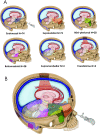Critical appraisal of minimally invasive keyhole surgery for intracranial meningioma in a large case series
- PMID: 35901061
- PMCID: PMC9333232
- DOI: 10.1371/journal.pone.0264053
Critical appraisal of minimally invasive keyhole surgery for intracranial meningioma in a large case series
Abstract
Background: Meningioma surgery has evolved over the last 20 years with increased use of minimally invasive approaches including the endoscopic endonasal route and endoscope-assisted and gravity-assisted transcranial approaches. As the "keyhole" concept remains controversial, we present detailed outcomes in a cohort series.
Methods: Retrospective analysis was done for all patients undergoing meningioma removal at a tertiary brain tumor referral center from 2008-2021. Keyhole approaches were defined as: use of a minimally invasive "retractorless" approach for a given meningioma in which a traditional larger approach is often used instead. The surgical goal was maximal safe removal including conservative (subtotal) removal for some invasive locations. Primary outcomes were resection rates, complications, length of stay and Karnofsky Performance Scale (KPS). Secondary outcomes were endoscopy use, perioperative treatments, tumor control and acute MRI FLAIR/T2 changes to assess for brain manipulation and retraction injury.
Results: Of 329 patients, keyhole approaches were utilized in 193(59%) patients (mean age 59±13; 30 (15.5%) had prior surgery) who underwent 213 operations; 205(96%) were skull base location. Approaches included: endoscopic endonasal (n = 74,35%), supraorbital (n = 73,34%), retromastoid (n = 38,18%), mini-pterional (n = 20,9%), suboccipital (n = 4,2%), and contralateral transfalcine (n = 4,2%). Primary outcomes: Gross total/near total (>90%) resection was achieved in 125(59%) (5% for petroclival, cavernous sinus/Meckel's cave, spheno-cavernous locations vs 77% for all other locations). Major complications included: permanent neurological worsening 12(6%), CSF leak 2(1%) meningitis 2(1%). There were no DVTs, PEs, MIs or 30-day mortality. Median LOS decreased from 3 to 2 days in the last 2 years; 94% were discharged to home with favorable 90-day KPS in 176(96%) patients. Secondary outcomes: Increased FLAIR/T2 changes were noted on POD#1/2 MRI in 36/213(17%) cases, resolving in all but 11 (5.2%). Endoscopy was used in 87/139(63%) craniotomies, facilitating additional tumor removal in 55%. Tumor progression occurred in 26(13%) patients, mean follow-up 42±36 months.
Conclusions & relevance: Our experience suggests minimally invasive keyhole transcranial and endoscopic endonasal meningioma removal is associated with comparable resection rates and low complication rates, short hospitalizations and high 90-day performance scores in comparison to prior reports using traditional skull base approaches. Subtotal removal may be appropriate for invasive/adherent meningiomas to avoid neurological deficits and other post-operative complications, although longer follow-up is needed. With careful patient selection and requisite experience, these approaches may be considered reasonable alternatives to traditional transcranial approaches.
Conflict of interest statement
The authors have read the journal’s policy and have the following competing interests: DFK receives royalties from Mizuho Inc. GB is a consultant for Vascular Technologies Inc. and Cerevasc Inc. outside of the current study. WS is a consultant for Stryker Corporation outside of the current study. This does not alter our adherence to PLOS ONE policies on sharing data and materials. There are no patents, products in development or marketed products associated with this research to declare.
Figures

Similar articles
-
Minimally invasive surgical treatment of intracranial meningiomas in elderly patients (≥ 65 years): outcomes, readmissions, and tumor control.Neurosurg Focus. 2020 Oct;49(4):E17. doi: 10.3171/2020.7.FOCUS20515. Neurosurg Focus. 2020. PMID: 33002879
-
Decision-making algorithm for minimally invasive approaches to anterior skull base meningiomas.Neurosurg Focus. 2018 Apr;44(4):E7. doi: 10.3171/2018.1.FOCUS17734. Neurosurg Focus. 2018. PMID: 29606040
-
Endonasal versus supraorbital keyhole removal of craniopharyngiomas and tuberculum sellae meningiomas.Neurosurgery. 2009 May;64(5 Suppl 2):269-84; discussion 284-6. doi: 10.1227/01.NEU.0000327857.22221.53. Neurosurgery. 2009. PMID: 19287324
-
Endoscopic Endonasal and Keyhole Surgery for Skull Base Meningiomas.Neurosurg Clin N Am. 2023 Jul;34(3):393-402. doi: 10.1016/j.nec.2023.02.003. Epub 2023 Mar 27. Neurosurg Clin N Am. 2023. PMID: 37210128 Review.
-
Endoscopic Endonasal and Keyhole Surgery for the Management of Skull Base Meningiomas.Neurosurg Clin N Am. 2016 Apr;27(2):207-14. doi: 10.1016/j.nec.2015.11.008. Epub 2016 Feb 18. Neurosurg Clin N Am. 2016. PMID: 27012385 Review.
Cited by
-
Supraorbital keyhole approaches in the first 3 years of practice: outcomes and lessons learned. Patient series.J Neurosurg Case Lessons. 2024 Mar 25;7(13):CASE23744. doi: 10.3171/CASE23744. Print 2024 Mar 25. J Neurosurg Case Lessons. 2024. PMID: 38531085 Free PMC article.
-
A Reliable Closure Technique for Retromastoid Craniotomy to Avoid Cerebrospinal Fluid Leaks and Meningitis.Neurosurg Pract. 2024 Jun 27;5(3):e00086. doi: 10.1227/neuprac.0000000000000086. eCollection 2024 Sep. Neurosurg Pract. 2024. PMID: 39959895 Free PMC article.
-
Clipping of anterior circulation aneurysms using fully endoscopic-assisted minimally invasive keyhole craniotomy: a clinical study and analysis.Neurosurg Rev. 2025 Mar 8;48(1):288. doi: 10.1007/s10143-025-03226-5. Neurosurg Rev. 2025. PMID: 40056234 Free PMC article.
-
Advancements in Imaging and Neurosurgical Techniques for Brain Tumor Resection: A Comprehensive Review.Cureus. 2024 Oct 31;16(10):e72745. doi: 10.7759/cureus.72745. eCollection 2024 Oct. Cureus. 2024. PMID: 39618625 Free PMC article. Review.
References
-
- Little K. M., Friedman A. H., Sampson J. H., Wanibuchi M., and Fukushima T. , "Surgical management of petroclival meningiomas: defining resection goals based on risk of neurological morbidity and tumor recurrence rates in 137 patients," Neurosurgery, vol. 56, no. 3, pp. 546–559, 2005. doi: 10.1227/01.neu.0000153906.12640.62 - DOI - PubMed
MeSH terms
LinkOut - more resources
Full Text Sources
Research Materials

